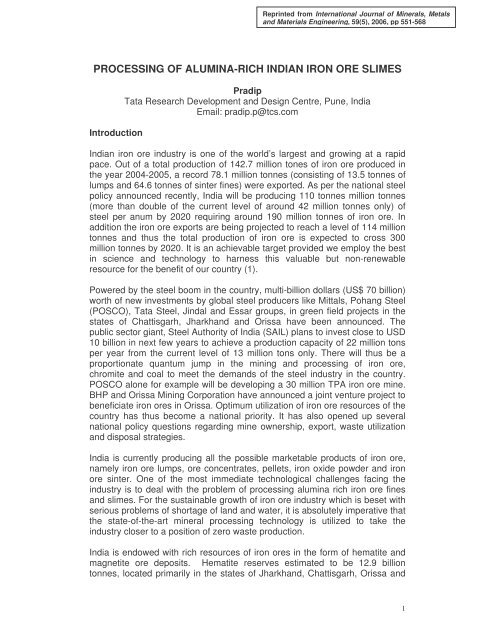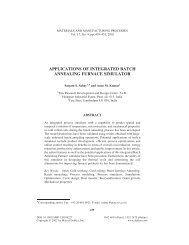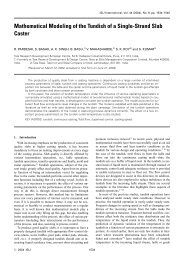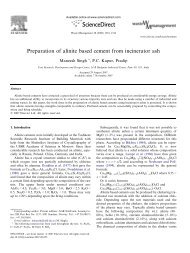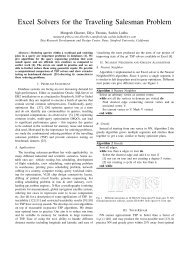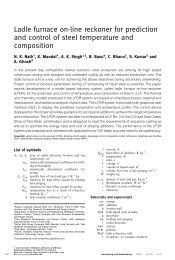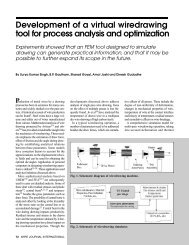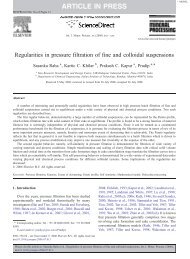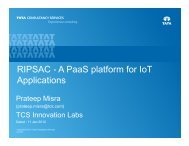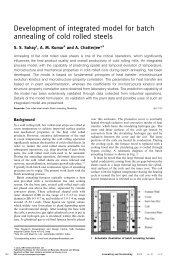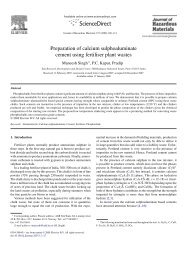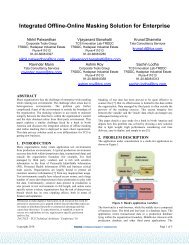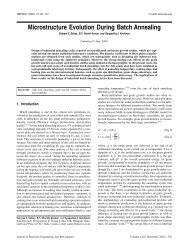processing of alumina-rich indian iron ore slimes - TRDDC
processing of alumina-rich indian iron ore slimes - TRDDC
processing of alumina-rich indian iron ore slimes - TRDDC
Create successful ePaper yourself
Turn your PDF publications into a flip-book with our unique Google optimized e-Paper software.
Reprinted from International Journal <strong>of</strong> Minerals, Metals<br />
and Materials Engineering, 59(5), 2006, pp 551-568<br />
PROCESSING OF ALUMINA-RICH INDIAN IRON ORE SLIMES<br />
Introduction<br />
Pradip<br />
Tata Research Development and Design Centre, Pune, India<br />
Email: pradip.p@tcs.com<br />
Indian <strong>iron</strong> <strong>ore</strong> industry is one <strong>of</strong> the world’s largest and growing at a rapid<br />
pace. Out <strong>of</strong> a total production <strong>of</strong> 142.7 million tones <strong>of</strong> <strong>iron</strong> <strong>ore</strong> produced in<br />
the year 2004-2005, a record 78.1 million tonnes (consisting <strong>of</strong> 13.5 tonnes <strong>of</strong><br />
lumps and 64.6 tonnes <strong>of</strong> sinter fines) were exported. As per the national steel<br />
policy announced recently, India will be producing 110 tonnes million tonnes<br />
(m<strong>ore</strong> than double <strong>of</strong> the current level <strong>of</strong> around 42 million tonnes only) <strong>of</strong><br />
steel per anum by 2020 requiring around 190 million tonnes <strong>of</strong> <strong>iron</strong> <strong>ore</strong>. In<br />
addition the <strong>iron</strong> <strong>ore</strong> exports are being projected to reach a level <strong>of</strong> 114 million<br />
tonnes and thus the total production <strong>of</strong> <strong>iron</strong> <strong>ore</strong> is expected to cross 300<br />
million tonnes by 2020. It is an achievable target provided we employ the best<br />
in science and technology to harness this valuable but non-renewable<br />
resource for the benefit <strong>of</strong> our country (1).<br />
Powered by the steel boom in the country, multi-billion dollars (US$ 70 billion)<br />
worth <strong>of</strong> new investments by global steel producers like Mittals, Pohang Steel<br />
(POSCO), Tata Steel, Jindal and Essar groups, in green field projects in the<br />
states <strong>of</strong> Chattisgarh, Jharkhand and Orissa have been announced. The<br />
public sector giant, Steel Authority <strong>of</strong> India (SAIL) plans to invest close to USD<br />
10 billion in next few years to achieve a production capacity <strong>of</strong> 22 million tons<br />
per year from the current level <strong>of</strong> 13 million tons only. There will thus be a<br />
proportionate quantum jump in the mining and <strong>processing</strong> <strong>of</strong> <strong>iron</strong> <strong>ore</strong>,<br />
chromite and coal to meet the demands <strong>of</strong> the steel industry in the country.<br />
POSCO alone for example will be developing a 30 million TPA <strong>iron</strong> <strong>ore</strong> mine.<br />
BHP and Orissa Mining Corporation have announced a joint venture project to<br />
beneficiate <strong>iron</strong> <strong>ore</strong>s in Orissa. Optimum utilization <strong>of</strong> <strong>iron</strong> <strong>ore</strong> resources <strong>of</strong> the<br />
country has thus become a national priority. It has also opened up several<br />
national policy questions regarding mine ownership, export, waste utilization<br />
and disposal strategies.<br />
India is currently producing all the possible marketable products <strong>of</strong> <strong>iron</strong> <strong>ore</strong>,<br />
namely <strong>iron</strong> <strong>ore</strong> lumps, <strong>ore</strong> concentrates, pellets, <strong>iron</strong> oxide powder and <strong>iron</strong><br />
<strong>ore</strong> sinter. One <strong>of</strong> the most immediate technological challenges facing the<br />
industry is to deal with the problem <strong>of</strong> <strong>processing</strong> <strong>alumina</strong> <strong>rich</strong> <strong>iron</strong> <strong>ore</strong> fines<br />
and <strong>slimes</strong>. For the sustainable growth <strong>of</strong> <strong>iron</strong> <strong>ore</strong> industry which is beset with<br />
serious problems <strong>of</strong> shortage <strong>of</strong> land and water, it is absolutely imperative that<br />
the state-<strong>of</strong>-the-art mineral <strong>processing</strong> technology is utilized to take the<br />
industry closer to a position <strong>of</strong> zero waste production.<br />
India is endowed with <strong>rich</strong> resources <strong>of</strong> <strong>iron</strong> <strong>ore</strong>s in the form <strong>of</strong> hematite and<br />
magnetite <strong>ore</strong> deposits. Hematite reserves estimated to be 12.9 billion<br />
tonnes, located primarily in the states <strong>of</strong> Jharkhand, Chattisgarh, Orissa and<br />
1
Madhya Pradesh are high grade (> 62% Fe) but also high in <strong>alumina</strong> content.<br />
Total magnetite reserves, estimated at around 10.6 billion tonnes with an<br />
average grade <strong>of</strong> 35-40% Fe are found in the states <strong>of</strong> Karnataka, Goa,<br />
Andhra Pradesh and Kerala. According to Indian Bureau <strong>of</strong> Mines, Indian <strong>iron</strong><br />
<strong>ore</strong> reserves are over 24 billion tonnes (1).<br />
Indian hematite <strong>ore</strong>s are typically <strong>rich</strong> in <strong>iron</strong> but contain unusually high<br />
<strong>alumina</strong> (as high as seven percent) and in some cases, problem <strong>of</strong> high<br />
phosphorous content is also noted. The current practice <strong>of</strong> <strong>iron</strong> <strong>ore</strong> washing<br />
in India results in three products, namely coarse <strong>ore</strong> lumps, directly charged<br />
to blast furnace, the classifier fines, (3-5% <strong>alumina</strong>) which with or without<br />
beneficiation are fed to sintering plants and the <strong>slimes</strong> (6-10% <strong>alumina</strong>) which<br />
are currently discarded as waste.<br />
It is a well-recognized fact that in order to enhance the competitive edge <strong>of</strong><br />
Indian <strong>iron</strong> and steel industry, an efficient <strong>alumina</strong> removal technology for<br />
Indian <strong>iron</strong> <strong>ore</strong>s is absolutely essential. It is worth noting the following facts in<br />
this context:<br />
• The <strong>alumina</strong> content in <strong>iron</strong> <strong>ore</strong> fines used in sinter making all over the<br />
world is less than 1%. In contrast, <strong>iron</strong> <strong>ore</strong> fines in India assay as high as<br />
3.0-5.5%. The sinter quality produced from such <strong>alumina</strong>-<strong>rich</strong> <strong>ore</strong> fines, is<br />
thus much po<strong>ore</strong>r. The adverse effect <strong>of</strong> <strong>alumina</strong> on sinter strength<br />
productivity and its reduction – degradation characteristics (RDI) are well<br />
documented and conclusively established (2-4).<br />
• Whether in the form <strong>of</strong> <strong>alumina</strong>-<strong>rich</strong> lumps or sinter, the blast furnace<br />
productivity is significantly affected due to the presence <strong>of</strong> <strong>alumina</strong> in the<br />
feed. High <strong>alumina</strong> slag which is highly viscous, requires larger quantity <strong>of</strong><br />
flux (10% MgO) and relatively larger slag volumes resulting in an increase<br />
in coke consumption and a decrease in blast furnace productivity.<br />
According to one estimate, a decrease in <strong>alumina</strong> content in the sinter<br />
from 3.1 to 2.5% will improve the RDI by at least six points, lower blast<br />
furnace coke rate by 14 kg per tonne <strong>of</strong> hot metal and increase its<br />
productivity by about 30% under Indian operating conditions (4-7).<br />
• The generation <strong>of</strong> <strong>iron</strong> <strong>ore</strong> <strong>slimes</strong> in India is estimated to be 10-25% by<br />
weight <strong>of</strong> the total <strong>iron</strong> <strong>ore</strong> mined – the <strong>iron</strong> <strong>ore</strong> values are lost to the tune<br />
<strong>of</strong> 15-20 million tonnes every year. In addition, these <strong>slimes</strong> st<strong>ore</strong>d in<br />
massive water ponds pose enormous env<strong>iron</strong>mental hazard. SAIL alone<br />
has m<strong>ore</strong> than 50 million tonnes <strong>of</strong> <strong>slimes</strong> accumulated over the years.<br />
Considering the fact that <strong>iron</strong> <strong>ore</strong> production will m<strong>ore</strong> than double and rise<br />
to at least 300 million tonnes soon, finding suitable means <strong>of</strong> safe<br />
disposal/utilization <strong>of</strong> <strong>slimes</strong> is indeed urgent.<br />
Motivation for the Beneficiation <strong>of</strong> Indian Iron Ores<br />
Iron <strong>ore</strong>s are being beneficiated all around the world including at Kudremukh<br />
in India. Several techniques such as spirals, floatex density separators, jigs,<br />
2
multi-gravity separator, low and high intensity magnetic separator,<br />
conventional as well as column flotation, selective dispersion – flocculation<br />
are all part <strong>of</strong> current industrial practice (8 -19). Recent advances include<br />
Batac jigs (20), packed flotation column (21) packed column jigs (22) and<br />
centrifugal concentrators like Falcon Concentrator (23) Kelsey jigs (24)<br />
Knelson Concentrator (24) for the beneficiation <strong>of</strong> <strong>iron</strong> <strong>ore</strong> <strong>slimes</strong>. Processing<br />
<strong>of</strong> hematitic <strong>ore</strong>s in India at present, however, does not involve any<br />
beneficiation except for whatever rejection <strong>of</strong> silica (and to some extent<br />
<strong>alumina</strong>) occurs during washing and classification <strong>of</strong> crushed <strong>ore</strong>s. Several<br />
commendable efforts have been made by Tata Steel to come up with an<br />
economically viable beneficiation flow sheet for <strong>processing</strong> classifier fines (25-<br />
28). M<strong>ore</strong> recently at least two beneficiation plants have been set up to<br />
process sinter fines for value addition.<br />
Tata Steel has commissioned a Batac jig <strong>of</strong> 300 tonnes per hour capacity at<br />
Noamundi to beneficiate sinter fines to achieve <strong>alumina</strong> content less than 2%<br />
(28). Essar (29) has pioneered the pellet route <strong>of</strong> utilizing fines. A state-<strong>of</strong>-theart<br />
<strong>iron</strong> <strong>ore</strong> fines <strong>processing</strong> plant including a 267 kilometers long slurry<br />
pipeline has been commissioned recently. Essar is operating an 8 million<br />
tonnes per anum pellet plant in Visakhapatnam based on the fines and <strong>slimes</strong><br />
being pumped from NMDC’s Balladilla <strong>iron</strong> <strong>ore</strong> mine. The beneficiation<br />
flowsheet includes gravity separation (spirals) <strong>of</strong> the coarser fraction after<br />
desliming and high intensity magnetic separation <strong>of</strong> the finer fraction. The<br />
concentrates thus produced assay less than 2.5% by weight <strong>of</strong> combined<br />
silica and <strong>alumina</strong> content and are further ground to produce a feed<br />
acceptable for the pelletization circuit. The Essar group has also announced<br />
to set up another 8 million tonnes per anum pellet plant as a part <strong>of</strong> its<br />
integrated steel unit in Orissa.<br />
A comprehensive technology development programme needed to delineate<br />
the appropriate beneficiation/utilization strategy for Indian <strong>iron</strong> <strong>ore</strong> deposits<br />
must include (i) the nature <strong>of</strong> occurrence, association and liberation<br />
characteristics <strong>of</strong> the <strong>alumina</strong> containing minerals; (ii) a comparison <strong>of</strong> the<br />
separation efficiency <strong>of</strong> various unit operations for both hematitegoethite/kaolinite/gibbsite<br />
separation in terms <strong>of</strong> recovery-grade plots<br />
(separation characteristics) and as a function <strong>of</strong> particle size (iii) a preliminary<br />
techno-economic assessment <strong>of</strong> the various technology options for a typical<br />
<strong>iron</strong> <strong>ore</strong> mine in the country. A schematic diagram showing the basic<br />
technological elements <strong>of</strong> an integrated strategy to utilize <strong>alumina</strong> <strong>rich</strong> <strong>iron</strong> <strong>ore</strong><br />
deposits in the country is presented in Fig. 1. The readers are referred to our<br />
earlier publications for m<strong>ore</strong> details (8-10). The discussion in this paper is<br />
confined to the possible beneficiation strategies for <strong>alumina</strong>- <strong>rich</strong> <strong>iron</strong> <strong>ore</strong><br />
<strong>slimes</strong> and that also, primarily to separation by flotation and selective<br />
flocculation techniques followed by semi-dry disposal <strong>of</strong> residue produced<br />
during the beneficiation. It must however be stressed that with ever increasing<br />
premium on bringing down the <strong>alumina</strong> content <strong>of</strong> Indian <strong>iron</strong> <strong>ore</strong>s to less than<br />
2%, preferably less than 1%, the generation <strong>of</strong> <strong>slimes</strong> as a proportion <strong>of</strong> the<br />
total mined output is likely to increase further. The development <strong>of</strong> an<br />
appropriate strategy to deal with <strong>alumina</strong>-<strong>rich</strong> <strong>iron</strong> <strong>ore</strong> <strong>slimes</strong> is theref<strong>ore</strong> <strong>of</strong><br />
great relevance and it is an urgent necessity.<br />
3
Blast furnace charge<br />
-40+10 mm<br />
Lumps<br />
1.9 % Al 2 O 3 -10+0.15 mm<br />
Tailing pond<br />
Slimes<br />
-0.15 mm<br />
~10 % Al 2 O 3<br />
Iron <strong>ore</strong><br />
(ROM)<br />
Fines<br />
2.7 % Al 2 O 3<br />
Sinter plant<br />
High <strong>alumina</strong> fines & <strong>slimes</strong><br />
En<strong>rich</strong>ed low<br />
<strong>alumina</strong> product<br />
Size<br />
enlargement<br />
Appropriate<br />
beneficiation strategy<br />
Blast furnace<br />
charge material<br />
• Sintering<br />
• Pelletization<br />
• Briquetting<br />
• Cold bonded -<br />
pelletization<br />
• Gravity separation<br />
• Magnetic separation<br />
• Froth flotation<br />
• Selective dispersion / flocculation<br />
• Bio - beneficiation<br />
Residual Waste<br />
• Semi-dry disposal<br />
Waste<br />
• Iron <strong>rich</strong> cements<br />
management<br />
• Thermal conversion<br />
strategy<br />
to <strong>iron</strong><br />
• Glass ceramics<br />
Value-added products<br />
Eco-friendly storage<br />
Fig. 1: An integrated approach to high <strong>alumina</strong> <strong>iron</strong> <strong>ore</strong><br />
beneficiation<br />
Beneficiation Strategies for Indian Iron Ore Slimes<br />
Considering the present magnitude <strong>of</strong> the <strong>iron</strong> <strong>ore</strong> <strong>slimes</strong> generation annually,<br />
the quantities <strong>of</strong> <strong>slimes</strong> accumulated over the years, the fact that these <strong>slimes</strong><br />
are available in already ground form and assaying reasonably high %Fe, it is<br />
obvious that if properly beneficiated, these <strong>slimes</strong> can be considered a<br />
national resource rather than a waste <strong>of</strong> nuisance value.<br />
The <strong>alumina</strong> content <strong>of</strong> the <strong>slimes</strong>, if brought to less than 2% Al 2 O 3 in the<br />
beneficiated product will (a) lead to better utilization <strong>of</strong> national resources (b)<br />
4
achieve higher mine output (enhanced production) with not much additional<br />
costs (c) reduce env<strong>iron</strong>mental hazards associated with storage and disposal<br />
<strong>of</strong> <strong>slimes</strong> and (d) result in higher blast furnace and sinter plant productivity<br />
A number <strong>of</strong> research groups in the country have expl<strong>ore</strong>d the possibility <strong>of</strong><br />
reducing <strong>alumina</strong> in <strong>iron</strong> <strong>ore</strong> <strong>slimes</strong> (8-10, 18, 19, 25-43) A critical review <strong>of</strong><br />
the earlier R&D investigations, as presented and discussed in greater detail in<br />
our earlier publications (8 -10), clearly indicates the need to carry out a<br />
comprehensive study targeted to establish an integrated strategy <strong>of</strong> utilization<br />
<strong>of</strong> Indian <strong>iron</strong> <strong>ore</strong> <strong>slimes</strong>. It must address the following important issues:<br />
• A quantitative and definitive assessment <strong>of</strong> the extent <strong>of</strong> <strong>alumina</strong> reduction<br />
possible with state-<strong>of</strong>-the-art beneficiation technology backed up by<br />
reliable scientific data<br />
• A conclusive evaluation <strong>of</strong> the state-<strong>of</strong>-the-art agglomeration (sintering/<br />
pelletization/ briquetting) technology which can successfully convert the<br />
beneficiated <strong>slimes</strong> into a product acceptable to blast furnace without<br />
adversely affecting its productivity<br />
• A techno-economic assessment <strong>of</strong> the various options available to utilize<br />
the residual “waste” product (it could be as high as 50%) containing high<br />
amount <strong>of</strong> <strong>alumina</strong> and <strong>iron</strong> oxide – for example, in the production <strong>of</strong> <strong>iron</strong><strong>rich</strong><br />
cements, recycling <strong>of</strong> <strong>iron</strong>-<strong>rich</strong> wastes by thermal treatment including<br />
conversion into metallic <strong>iron</strong> and in the production <strong>of</strong> glass ceramic<br />
materials from <strong>iron</strong>-<strong>rich</strong> waste<br />
• A comprehensive eco-friendly and safe technology (for example, semi-dry<br />
disposal technology) to replace the conventional practice <strong>of</strong> storing <strong>iron</strong><br />
<strong>ore</strong> <strong>slimes</strong> in tailings ponds<br />
One <strong>of</strong> the m<strong>ore</strong> important findings <strong>of</strong> earlier investigations is that <strong>alumina</strong> in<br />
Indian <strong>iron</strong> <strong>ore</strong> <strong>slimes</strong> occurs in the form <strong>of</strong> two distinct mineral constituents<br />
namely, gibbsite (hydrated aluminium oxides) and kaolinite (and other clay<br />
minerals in minor quantities). Even though not adequately quantified, the<br />
liberation studies also indicate that a substantial portion <strong>of</strong> <strong>alumina</strong> is present<br />
in the liberated form and hence amenable to separation by physical means.<br />
The work conducted by Tata Steel on Noamundi <strong>iron</strong> <strong>ore</strong> <strong>slimes</strong> is by far the<br />
most comprehensive study available at present. Based on their data, Pradip<br />
(9) compared the efficiencies <strong>of</strong> different unit operations including wet high<br />
intensity magnetic separation (WHIMS) and multi-gravity separator (MGS). As<br />
illustrated in Fig.2, it was possible to produce concentrates, at least on a<br />
laboratory scale; assaying less than 2% <strong>alumina</strong> at an overall yield <strong>of</strong> around<br />
50% from <strong>slimes</strong> feed analyzing 7-8 % <strong>alumina</strong>. Another noteworthy<br />
observation is that the separation achieved in MGS is remarkably close to the<br />
the<strong>ore</strong>tical yield predicted based on the sink-float tests done on the same<br />
sample <strong>of</strong> <strong>slimes</strong>. The availability <strong>of</strong> high capacity MGS units is currently a<br />
serious limitation.<br />
5
Based on the published literature on the beneficiation <strong>of</strong> Indian <strong>iron</strong> <strong>ore</strong><br />
<strong>slimes</strong>, it is not possible to conclude the reasons why the yield is limited to<br />
50% only. Is it because <strong>of</strong> interlocking and/or because <strong>of</strong> lack <strong>of</strong> a suitable<br />
separation device? Any future work on this topic must address this question.<br />
M<strong>ore</strong> importantly, the efficiency <strong>of</strong> various unit operations must be compared<br />
on the basis <strong>of</strong> such plots rather than a single point result (recovery at a<br />
specified grade) which is <strong>of</strong>ten misleading. Another benefit <strong>of</strong> such plots is<br />
that one can also assess the pros and cons <strong>of</strong> specifying a particular grade <strong>of</strong><br />
the concentrate. In case there is a sharp drop observed in recovery with<br />
grade, one has to be careful in targeting a particular concentrate grade since<br />
it may or may not be possible to achieve it through a robust industrial<br />
separation circuit. Sensitivity <strong>of</strong> these results with respect to different feed<br />
grades, for feeds from different mine areas and feeds <strong>of</strong> different size<br />
distributions must be studied since all physical separation processes are<br />
known to be sensitive to particle size, mineralogy, liberation and feed grade.<br />
Fig. 2: Beneficiation <strong>of</strong> Noamundi <strong>iron</strong> <strong>ore</strong> <strong>slimes</strong> – the separation efficiency<br />
(yield as a function <strong>of</strong> <strong>alumina</strong> content <strong>of</strong> the concentrate) <strong>of</strong> various<br />
unit operations compared (After Ref. 9)<br />
Separation processes based on the surface-chemical differences between<br />
<strong>iron</strong> and <strong>alumina</strong> containing minerals, for example, froth flotation and selective<br />
dispersion – flocculation are also promising but have not been investigated<br />
adequately for <strong>processing</strong> Indian <strong>iron</strong> <strong>ore</strong>s. These two separation techniques<br />
are theref<strong>ore</strong> discussed in greater detail in this communication. The<br />
availability <strong>of</strong> selective reagents capable <strong>of</strong> achieving the desired separation<br />
efficiencies is a serious limitation. It has been addressed by us in our work on<br />
<strong>iron</strong> <strong>ore</strong> <strong>slimes</strong> (8-10, 37-41).<br />
6
Froth Flotation <strong>of</strong> Iron Ore Slimes<br />
Flotation process for concentrating <strong>iron</strong> <strong>ore</strong>s received a big impetus in USA<br />
immediately after the Second World War due to the dwindling resources <strong>of</strong><br />
direct shipping <strong>iron</strong> <strong>ore</strong>s in the Lake Superior District. Flotation <strong>of</strong> <strong>iron</strong> <strong>ore</strong>s<br />
essentially for silica removal has been reviewed extensively in literature (8-10,<br />
13, 16, 44-53). The <strong>iron</strong> <strong>ore</strong> industry in Minnesota and Michigan in US uses<br />
cationic flotation <strong>of</strong> silica from magnetic taconites at a rate <strong>of</strong> 40 million tons<br />
per annually (44). Column flotation technology for rejecting fine silica using a<br />
variety <strong>of</strong> cationic amines has also been commercialized in <strong>iron</strong> <strong>ore</strong> industry<br />
including at Kudremukh in India.<br />
Several <strong>iron</strong> <strong>ore</strong> producers in Brazil employ reverse flotation separation <strong>of</strong><br />
silica from <strong>iron</strong> <strong>ore</strong> minerals for producing pellet quality concentrates. It has<br />
been reported that the presence <strong>of</strong> gibbsite and/or kaolinite as the major<br />
<strong>alumina</strong> containing minerals in <strong>iron</strong> <strong>ore</strong>s does dictate the choice <strong>of</strong><br />
beneficiation flow sheet (47) While kaolinite does not interfere with flotation<br />
selectivity, gibbsite tends to contaminate the flotation concentrate as it is<br />
depressed together with <strong>iron</strong> oxides and hydroxides during the reverse<br />
cationic flotation process (47). These observations are remarkably close to<br />
what Pradip and co-workers (8-10, 41) have reported based on their<br />
investigations on the beneficiation <strong>of</strong> Indian <strong>iron</strong> <strong>ore</strong> <strong>slimes</strong> by flotation and<br />
selective flocculation. Gibbsite tends to go with <strong>iron</strong> oxide because <strong>of</strong> its<br />
surface chemistry and chelating chemistry being very similar to <strong>iron</strong> oxide<br />
minerals. In fact the separation <strong>of</strong> <strong>iron</strong> oxide from gibbsite continues to remain<br />
a challenge bef<strong>ore</strong> mineral engineers.<br />
In order to process finely disseminated large deposits <strong>of</strong> oxidized taconites<br />
containing predominantly hematite and goethite, US Bureau <strong>of</strong> Mines in the<br />
late sixties developed a process involving selective flocculation and desliming<br />
followed by cationic flotation <strong>of</strong> coarse silica. It was commercialized for the<br />
first time in 1974 at the Cleveland Cliffs Iron Co’s Tilden Concentrator in USA<br />
(17). The 4.1 million tons per year capacity plant was later expanded to<br />
produce 8.2 million tons per year <strong>of</strong> pellets assaying 64%Fe. The plant flow<br />
sheet involves dispersion <strong>of</strong> minerals using sodium hydroxide in combination<br />
with sodium silicate/ lignosulfonates / hexametaphosphate or<br />
tripolyphosphates during grinding followed by selective flocculation <strong>of</strong> <strong>iron</strong><br />
minerals using starches (for example, tapioca flour starch). The settled<br />
(flocculated) concentrate is then subjected to reverse flotation with cationic<br />
amine reagents in order to remove coarse silicates. Starch thus works both as<br />
a selective flocculant and as a depressant for <strong>iron</strong> minerals.<br />
Samarco, a joint venture between BHP Billiton and CVRD operates a flotation<br />
concentrator producing an <strong>iron</strong> <strong>ore</strong> concentrate which is pumped via a 396<br />
kilometer pipeline to a pellet plant in Brazil. In order to reduce the silica<br />
content from present level <strong>of</strong> 3.1 % to less than 1% (super concentrate),<br />
regrinding to 100 % passing 105 microns was found to be most appropriate<br />
for enhanced liberation bef<strong>ore</strong> flotation (53).<br />
7
In summary, a critical review <strong>of</strong> the published literature on the flotation <strong>of</strong> <strong>iron</strong><br />
<strong>ore</strong> minerals suggests that it is likely to be a cost-effective commercial<br />
proposition for the beneficiation <strong>of</strong> Indian <strong>iron</strong> <strong>ore</strong> <strong>slimes</strong> provided one is able<br />
to design a selective flotation collector for <strong>iron</strong> oxide – gibbsite separation.<br />
Flotation <strong>of</strong> Iron <strong>ore</strong>s for Phosphate Removal<br />
So far as the separation <strong>of</strong> apatite from <strong>iron</strong> <strong>ore</strong> minerals is concerned,<br />
flotation has been observed to be the most appropriate process. Depending<br />
on the mineralogy <strong>of</strong> occurrence <strong>of</strong> phosphate in <strong>iron</strong> <strong>ore</strong>s, appropriate<br />
selective reagents have to be selected and/or designed to achieve acceptable<br />
grades <strong>of</strong> flotation concentrates. The magnetite <strong>ore</strong> available at LKAB’s<br />
Kiruna deposit in Sweden contains about 1 wt % <strong>of</strong> phosphorous. The<br />
phosphate minerals are floated with the help <strong>of</strong> a proprietary reagent<br />
developed by AKZO Nobel for this separation (50-52). The flotation collector,<br />
ATRAC-1562, found to be most effective in this flotation separation is a<br />
modified fatty acid reagent. It is possible to achieve a flotation concentrate<br />
grade assaying 0.025 % P and 71% Fe (acceptable for pellet plant) from a<br />
feed assaying 61% Fe and 1% P at a throughput rate <strong>of</strong> 3.8 million tons per<br />
year. A process control system is installed to be able to maintain the<br />
concentrate grade. Besides reagent dosage, and pH, the pulp temperature<br />
(varies between 10 to 40 0 C) is also observed to affect the flotation kinetics as<br />
well as the selectivity <strong>of</strong> separation (50).<br />
Cleveland Cliffs is the largest producer <strong>of</strong> <strong>iron</strong> <strong>ore</strong> pellets in North America<br />
with a combined production capacity <strong>of</strong> 38 million tons and operating six<br />
mines located in Michigan, Minnesota and Eastern Canada (54). While the<br />
majority <strong>of</strong> pellets assay in the range <strong>of</strong> 0.01 to 0.02% P, the pellets produced<br />
from martite <strong>ore</strong>s (Tilden Mine) tend to have higher phosphorus and hence its<br />
reduction is an ongoing challenge. The Tilden plant flow sheet consists <strong>of</strong> very<br />
fine grinding to 80% passing 25 microns followed by selective flocculation –<br />
desliming process step whereby a significant portion <strong>of</strong> siliceous gangue,<br />
goethite <strong>slimes</strong> and phosphorous containing minerals are rejected. Reverse<br />
amine flotation is utilized to further bring down the silica content <strong>of</strong> the<br />
concentrate to meet the pellet quality grade. pH is maintained near 11.<br />
Previous research indicated two modes <strong>of</strong> phosphorus occurrence, namely in<br />
the form <strong>of</strong> discrete apatite grains as well as in the form <strong>of</strong> solid solution in<br />
goethite grains (54). Since apatite grains exhibits strong<br />
cathodoluminescence, the cathodoluminescence microscopy (CLM) technique<br />
has been successfully utilized to investigate the nature <strong>of</strong> phosphorus<br />
occurrence in <strong>iron</strong> <strong>ore</strong>s (54). A CLM detector is added to the SEM for <strong>ore</strong><br />
characterization.<br />
8
Selective Dispersion-Flocculation Studies on Iron Ore Slimes<br />
Pradip and co-workers (8-10, 37-41) have systematically investigated the<br />
possibility <strong>of</strong> achieving selective separation amongst hematite- <strong>alumina</strong>kaolinite-<br />
montmorillonite minerals, the mineral constituent’s representative <strong>of</strong><br />
Indian <strong>iron</strong> <strong>ore</strong> <strong>slimes</strong>.<br />
Two classes <strong>of</strong> commercially available flocculants namely starch based<br />
natural polymers and polyacrylamide (PAM) - polyacrylic acid (PAA) family <strong>of</strong><br />
synthetic polymers were extensively tested. Statistically designed experiments<br />
were conducted in order to compare the efficiencies <strong>of</strong> the two polymers<br />
namely starch and PAA for selective separation <strong>of</strong> hematite from kaolinite. As<br />
illustrated in Fig. 3. Starch at pH 10 is found to be a much m<strong>ore</strong> selective<br />
reagent for this separation (41).<br />
Pradip et al. (8, 38, 41) have also established that as compared to the<br />
commonly used dispersant, sodium silicate, low molecular weight synthetic<br />
polymers such as polyethylene oxide (PEO) and polyvinyl pyrrolidone (PVP)<br />
are m<strong>ore</strong> selective dispersants for hematite-kaolinite separation with PAA as a<br />
flocculant. It is interesting to note that this effect <strong>of</strong> various dispersants on<br />
selectivity is not observed in case starch is used as a flocculant.<br />
Fig. 3: A comparison <strong>of</strong> the efficiency <strong>of</strong> polyacrylic acid (PAA) and starch<br />
flocculants in the separation <strong>of</strong> hematite from its mixtures with kaolinite<br />
in the pH range 6.5-9 for PAA and 9.5-11.5 for starch (After Ref. 41)<br />
Pradip and co-workers have also modified starch as well as polyacrylamides<br />
by incorporating m<strong>ore</strong> selective functional groups. Modified polyacrylamides<br />
containing <strong>iron</strong> chelating groups such as hydroxamates, (PAMX) were, for<br />
example are found to be much m<strong>ore</strong> selective than PAA or PAM. The<br />
9
epresentative results on the separation efficiency <strong>of</strong> PAMX in hematitekaolinite<br />
separation are presented in Table 1 (37).<br />
Table 1: Enhancement in selectivity in <strong>iron</strong> oxide/kaolin separation by the<br />
introduction <strong>of</strong> hydroxamate functional groups in polyacrylamide<br />
Feed grade: 35% Fe (1:1 mixture)<br />
Pulp density: 1% Dispersant: 40 mg/l Na-Silicate<br />
Test<br />
Results<br />
Conditions<br />
Flocculant<br />
pH Dosage Grade Recovery<br />
(mg/l)<br />
Name CONH 2 COOH CONHOH (%) (%)<br />
None 10 - 63.6 50.0<br />
PAM 100 - - 9 1 55.5 57.5<br />
PAA - 100 - 9 2 61.6 74.0<br />
PAMX* 68.7 23 8.3 9.2 5 66.5 72.0<br />
* 8.3% - CONHOH (hydroxamate) and 23% COOH (carboxylate) and rest<br />
CONH 2 (acrylamide) functional groups<br />
[ CH 2 CH] x<br />
[ CH 2 CH] y<br />
C O C O<br />
NH<br />
O - H +<br />
PAMX<br />
O - H +<br />
[ CH 2 CH] z<br />
C O<br />
NH 2<br />
The deleterious effect <strong>of</strong> the presence <strong>of</strong> montmorillonite in the system was<br />
also studied in detail (55). Flocculation experiments conducted on the<br />
synthetic mixtures <strong>of</strong> hematite-kaolinite-montmorillonite indicated that as little<br />
as 5% <strong>of</strong> montmorillonite when introduced in hematite-kaolinite mixtures could<br />
lead to a marked deterioration in the separation efficiency due to relatively<br />
less flocculation <strong>of</strong> hematite in presence <strong>of</strong> montmorillonite. Kaolinite<br />
flocculation remained largely unaffected. This deleterious effect <strong>of</strong><br />
montmorillonite could be partially mitigated by the use <strong>of</strong> modified flocculants<br />
containing m<strong>ore</strong> selective functional groups. The selectivity could be partially<br />
rest<strong>ore</strong>d when modified starch-mercaptan was used as a flocculant instead <strong>of</strong><br />
conventional maize starch. The beneficial effect <strong>of</strong> a m<strong>ore</strong> selective flocculant<br />
like starch mercaptan was observed with synthetic dispersants as well (55).<br />
An interesting finding <strong>of</strong> our work is that starch, modified starches and<br />
modified polyacrylamides (PAMX) which were found to be excellent<br />
flocculants for selective separation <strong>of</strong> hematite from kaolinite and even<br />
montmorillonite, turned out to be disastrous in hematite-gibbsite separation. In<br />
fact, we established that starch flocculated both <strong>alumina</strong> (gibbsite) and<br />
10
hematite (<strong>iron</strong> oxide) equally well. It is well known that <strong>iron</strong> oxide and <strong>alumina</strong><br />
have identical crystal structures. The results for hematite (<strong>iron</strong> oxide) –<br />
kaolinite and hematitie – <strong>alumina</strong> separation using starch are shown in Fig. 4<br />
for illustration (8, 56).<br />
100<br />
Fe2O3 - KAOLINITE<br />
80<br />
WEIGHT PERCENT SETTLED<br />
60<br />
40<br />
20<br />
MAIZE STARCH<br />
1% SOLIDS<br />
1:1 MIXTURE<br />
pH 10.5<br />
Fe 2 O 3<br />
KAOLINITE<br />
Fe 2<br />
O 3<br />
Al 2<br />
O 3<br />
SODIUM<br />
SILICATE (mg/l)<br />
40<br />
80<br />
Fe2O3 - Al 2<br />
O 3<br />
0<br />
0 10 20 30 40 50<br />
0 10 20 30 40 50<br />
FLOCCULANT DOSAGE, mg/l<br />
Fig.4.: Selective flocculation <strong>of</strong> hematite (Fe 2 O 3 ) from its synthetic mixture with<br />
<strong>alumina</strong> (Al 2 O 3 ) and kaolinite using a natural maize starch flocculant at<br />
pH 10.5 + 0.1 in presence <strong>of</strong> sodium silicate dispersant (After Ref. 8)<br />
We have also proposed a molecular recognition mechanism underlying starch<br />
interaction with <strong>iron</strong> oxide and <strong>alumina</strong> which explains this observation (41,<br />
56). The adsorption mechanism for starch end group having O - O distance <strong>of</strong><br />
2.85 A° interacting with <strong>iron</strong> oxide substrate having Fe - Fe distance <strong>of</strong> 2.85<br />
A° on its cleavage plane is schematically shown in Fig.5. Al-Al distance on<br />
the cleavage plane <strong>of</strong> corundum (Al 2 O 3 ) is exactly same and hence strong<br />
interaction and flocculation <strong>of</strong> <strong>alumina</strong> (Al 2 O 3 ) is observed with starch.<br />
Fig.5: A schematic diagram illustrating the mechanism <strong>of</strong> starch adsorption<br />
through binuclear complexation with Fe sites on hematite surface or Al<br />
sites on Al 2 O 3 surface (After Ref. 41)<br />
11
Various research groups including ours have reported on the lack <strong>of</strong> any<br />
worthwhile success in the beneficiation <strong>of</strong> natural <strong>iron</strong> <strong>ore</strong> <strong>slimes</strong> using<br />
commonly used dispersant–flocculant combinations. Based on our<br />
systematic work on delineating the reasons for this observation, we attribute it<br />
to the remarkable similarities in the crystal structure as well as the surface<br />
chemical properties <strong>of</strong> the two constituent minerals <strong>of</strong> <strong>iron</strong> <strong>ore</strong> <strong>slimes</strong> namely<br />
hematite (<strong>iron</strong> oxide) and gibbsite (<strong>alumina</strong>).<br />
While kaolinite separation is possible with certain modified flocculants<br />
synthesized by us, even in presence <strong>of</strong> minor quantities <strong>of</strong> montmorillonite, it<br />
is not enough to reduce <strong>alumina</strong> to the desired levels in the concentrate<br />
because gibbsite remains with hematite. The key to solving the problem <strong>of</strong><br />
<strong>iron</strong> <strong>ore</strong> <strong>slimes</strong> thus lies in developing selective reagents (flocculants,<br />
dispersants and flotation collectors) for <strong>iron</strong> oxide – gibbsite separation. This<br />
is by no means a trivial task but any breakthroughs on this front, in the<br />
author’s opinion will have far-reaching impact on the techno-economics <strong>of</strong><br />
<strong>processing</strong> <strong>alumina</strong>-<strong>rich</strong> <strong>iron</strong> <strong>ore</strong> <strong>slimes</strong>. These reagents are not only essential<br />
for solving the problem <strong>of</strong> <strong>alumina</strong> <strong>rich</strong> <strong>iron</strong> <strong>ore</strong> <strong>slimes</strong> but those will also have<br />
a significant impact on the beneficiation <strong>of</strong> <strong>iron</strong>-<strong>rich</strong> bauxite deposits in India.<br />
Processing <strong>of</strong> Indian red muds, <strong>rich</strong> in <strong>alumina</strong> and <strong>iron</strong> oxide will also<br />
become economically m<strong>ore</strong> attractive with the availability <strong>of</strong> reagents capable<br />
<strong>of</strong> <strong>iron</strong> oxide– gibbsite separation. A sustained and systematic interdisciplinary<br />
effort by Indian researchers in this direction is theref<strong>ore</strong> urgently needed.<br />
State-<strong>of</strong>-the-art molecular modeling techniques appear to be promising for the<br />
design <strong>of</strong> highly selective, tailor-made reagents for industrial applications (56-<br />
62).<br />
Pelletization and Sintering <strong>of</strong> Beneficiated Iron <strong>ore</strong> Slimes<br />
In India, Kudremukh Iron Ore Co. (KIOCL), Mandovi Pellets, Jindal<br />
Vijayanagar Steel Ltd (JVSL) and Essar are producing <strong>iron</strong> <strong>ore</strong> pellets <strong>of</strong><br />
marketable grade. While a discussion on the overall techno-economics <strong>of</strong><br />
pelletization vis-à-vis sintering <strong>of</strong> <strong>iron</strong> <strong>ore</strong> <strong>slimes</strong> is outside the scope <strong>of</strong> this<br />
paper, it is worth mentioning that major technological advances have taken<br />
place in both the processes leading to improvement in productivity and quality<br />
<strong>of</strong> pellets and sinter.<br />
One <strong>of</strong> the m<strong>ore</strong> recent innovations has been the demonstrated utility <strong>of</strong> High<br />
Pressure Grinding Rolls (HPGR) for the production <strong>of</strong> pellet feed. Modern <strong>iron</strong><br />
<strong>ore</strong> pellet plants consist <strong>of</strong> HPGR for grinding the feed to acceptable levels <strong>of</strong><br />
fineness with comparatively less consumption <strong>of</strong> energy (63). One <strong>of</strong> the very<br />
first installations <strong>of</strong> HPGR in the <strong>iron</strong> <strong>ore</strong> industry was at LKAB in Sweden in<br />
1994. Currently there are 29 HPGR units operating worldwide in the <strong>iron</strong> <strong>ore</strong><br />
industry including one at Kurdremukh in India (63). Besides low specific<br />
energy consumption and high throughput per machine, the pellet specific<br />
advantages <strong>of</strong> HPGR machine include increase in fineness, m<strong>ore</strong> appropriate<br />
size distribution and shape <strong>of</strong> HPGR product compared to grinding in<br />
conventional ball mills, increase ultrafines in the product, m<strong>ore</strong> uniform pellets<br />
12
esulting in reduction in circulating loads, better moisture control in filtration,<br />
higher density <strong>of</strong> pellets (average porosity decreased from 33 % to 25 %),<br />
lower binder requirement and increased green pellet strengths (upto 50%<br />
higher than conventional pellets), reduced fuel consumption, higher loading,<br />
better bed permeability and increased productivity during induration (63).<br />
Some <strong>of</strong> these benefits are illustrated with data reported by Ehrentraut and<br />
Ramachandra Rao (2001) on the quality <strong>of</strong> pellets obtained at Kudremukh<br />
Iron Ore Pellet plant in India (64).<br />
Table 2: A comparison <strong>of</strong> pellet properties with and without roller press as<br />
obtained at Kudremukh Iron Ore Company (Ref 64)<br />
Parameter<br />
Without<br />
Roller<br />
Press<br />
With Roller<br />
press<br />
Blaine value <strong>of</strong> feed on pelletizing disc (cm 2 /g) 1450 1800<br />
Green Pellets (wt%) <strong>of</strong> 9-16 mm 86 90<br />
Green Pellets (wt%) <strong>of</strong> < 5 mm 2 1.5<br />
No <strong>of</strong> drops – Green Pellets Strength 7 10<br />
Tumbler Index after induration, wt% <strong>of</strong> > 6.3 mm fr. 94.5 95<br />
Abrasion index, wt% <strong>of</strong> < 0.6 mm 4.5 4.0<br />
Porosity (%) 29 26<br />
Swelling Index (%) 17 15<br />
Reducibility (%) 64 62<br />
Bulk Density (t/m 3 ) 2 2.24<br />
Significant improvements in terms <strong>of</strong> quality and productivity in <strong>iron</strong> <strong>ore</strong> pellet<br />
plants have been achieved through the introduction <strong>of</strong> advanced process<br />
control systems including expert systems (65-67).<br />
It is well known that sintering plants can be appropriately modified to accept<br />
higher levels <strong>of</strong> fines/<strong>slimes</strong>, for example by micro-pelletizing the <strong>slimes</strong><br />
bef<strong>ore</strong> sintering. To the best <strong>of</strong> my knowledge I have not come across any<br />
investigation on Indian <strong>iron</strong> <strong>ore</strong> fines, carried out to establish the proportion <strong>of</strong><br />
<strong>slimes</strong> one can accept in sinter plants without adversely affecting their<br />
performance. Such investigations must be conducted as a part <strong>of</strong> the R&D<br />
program on beneficiation <strong>of</strong> <strong>iron</strong> <strong>ore</strong> <strong>slimes</strong>.<br />
Next generation Technology for Safe Disposal <strong>of</strong> Iron Ore Slimes<br />
Residue after Beneficiation<br />
No discussion on <strong>processing</strong> <strong>of</strong> Indian <strong>iron</strong> <strong>ore</strong> <strong>slimes</strong> is complete without a<br />
mandatory section on the env<strong>iron</strong>mentally acceptable recycling and/or storage<br />
<strong>of</strong> residual waste after beneficiation. No matter which process <strong>of</strong> beneficiation<br />
is employed, it is clear that with existing technologies one is able to recover<br />
only 50% <strong>of</strong> the <strong>slimes</strong> as a valuable product. The <strong>iron</strong> <strong>rich</strong> alumino-silicate<br />
residue is thus available for further <strong>processing</strong> and/or safe disposal. Current<br />
practice <strong>of</strong> storing <strong>slimes</strong> in huge dams built for this purpose not only occupy<br />
precious land but also hazardous to the population. In response to this need<br />
to find an alternative to current tailings disposal schemes, an innovative<br />
13
thickened tailings disposal technique has been invented and commercialized<br />
recently. It is very much relevant to the present discussion on <strong>processing</strong> <strong>of</strong><br />
<strong>iron</strong> <strong>ore</strong> <strong>slimes</strong>.<br />
The conventional technology <strong>of</strong> tailings disposal/storage involves building an<br />
expensive tailings dam or a tailings pond where million <strong>of</strong> tons <strong>of</strong> very dilute<br />
and fine particulate suspensions are allowed to settle under gravity for several<br />
years. The industry is well aware <strong>of</strong> the inherent problems/hazards associated<br />
with this strategy.<br />
The widely prevalent practice <strong>of</strong> disposal and management <strong>of</strong> tailings entails<br />
dilution with water, pipe line transportation <strong>of</strong> relatively dilute slurry and<br />
impoundment in a pond or tailings dam. This so-called third generation<br />
technology has associated with it immense hidden costs and potential for<br />
serious env<strong>iron</strong>mental damage (68). Apart from locking up vast quantities <strong>of</strong><br />
water and valuable land for generations on end, it poses a man-made hazard<br />
to the soil and water sub-systems <strong>of</strong> the env<strong>iron</strong>ment with unpredictable and<br />
far-reaching consequences for the ecosystem and the habitat. There is then a<br />
need for the development <strong>of</strong> an env<strong>iron</strong>mentally benign and cost effective<br />
technology for disposal and management <strong>of</strong> wet particulate wastes. The<br />
imperative for an alternate approach is even m<strong>ore</strong> urgent in the Indian context<br />
where water is a scarce resource, land is at premium, and env<strong>iron</strong>mental<br />
degradation has already reached alarming proportions.<br />
Thickened tailings disposal (TTD) is a concept introduced by Robinsky (1975)<br />
and commercialized only very recently in the mining industry. The success <strong>of</strong><br />
a TTD system depends on the extent the tailing can be thickened to<br />
concentrated but pumpable slurry. Once thickened, the tailings can be<br />
pumped and discharged in the form <strong>of</strong> a self-supporting ridge/cone designed<br />
to attain a slope <strong>of</strong> 2% to 6% only. This new technology obviates the need <strong>of</strong><br />
building dams/ponds and is theref<strong>ore</strong> going to have a major impact in the<br />
industry (68 - 80).<br />
Excellent work <strong>of</strong> David Boger and coworkers (73-80) has provided the<br />
necessary scientific foundations to this new concept <strong>of</strong> tailings disposal. The<br />
basic science underlying the dewatering, pumping and stacking <strong>of</strong> mineral<br />
slurries (also called “particulate fluids”) is thus understood to a great extent<br />
and hence, this “fourth” generation technology <strong>of</strong> tailings disposal is ready for<br />
wider application in the industry. This concept has been adopted and<br />
perfected as a semi-dry disposal technology treating red-mud (a residue <strong>of</strong><br />
bauxite <strong>processing</strong>) by Alcoa <strong>of</strong> Australia (75, 80).<br />
The results obtained after a comprehensive characterization <strong>of</strong> the Alcoa ‘red<br />
mud’, were utilized to optimize design and the semi-dry disposal system for<br />
the bauxite residue produced by Alcoa in Western Australia (75). Depending<br />
on the rheological characteristics <strong>of</strong> the given red-mud, it was shown that<br />
there exists an optimum solid concentration (wt% solids) in the slurry at which<br />
it should be pumped.<br />
14
The rate and extent <strong>of</strong> thixotropic break down <strong>of</strong> the red mud slurry as a<br />
function <strong>of</strong> mixing time are gainfully exploited in this process. The results<br />
clearly indicate that destruction <strong>of</strong> network structure by mechanical agitation<br />
leads to the reduction in yield stress (a measure <strong>of</strong> the slurry’s resistance to<br />
flow) by several orders <strong>of</strong> magnitude. It is even m<strong>ore</strong> interesting to note the<br />
rate <strong>of</strong> recovery <strong>of</strong> the structure (and hence rise in yield stress) <strong>of</strong> red mud as<br />
a function <strong>of</strong> time in the absence <strong>of</strong> shear. Recovery is slower by an order <strong>of</strong><br />
magnitude than degradation. This property <strong>of</strong> red mud is exploited in pipeline<br />
transport at high percent solids followed by semi-dry discharge at the disposal<br />
site and subsequent consolidation <strong>of</strong> red mud slurries (75).<br />
Based on the work <strong>of</strong> Boger and coworkers, Alcoa commissioned a<br />
demonstration plant in Kwinana in 1984. Subsequently, a semi-dry disposal<br />
method was commissioned at Pinjarra refinery in 1985. Later three high<br />
density super thickeners to produce highly concentrated slurries were built<br />
and are in use. The largest <strong>of</strong> these operations consists <strong>of</strong> a thickener having<br />
a diameter <strong>of</strong> 90 metres with 10 metres deep compression zone, a capacity <strong>of</strong><br />
450 tons per hour, use 60 g flocculant per ton <strong>of</strong> red mud and produces a<br />
50% solids underflow which is pumped to a 70 hectares drying area where by<br />
it is discharged by the slope thickened tailings disposal (TTD) method (75).<br />
Recent developments in multi-disciplinary researches at the intersection <strong>of</strong><br />
colloid science, yield rheology and <strong>processing</strong> <strong>of</strong> particulate fluids suggest<br />
that it should now be possible to develop/optimize the fourth generation<br />
technology, which can be optimally tail<strong>ore</strong>d for a specific waste management<br />
problem, for example disposal/storage <strong>of</strong> <strong>iron</strong> <strong>ore</strong> <strong>slimes</strong>/residue. The subprocesses<br />
that need to be embedded in this novel technology for<br />
disposal/storage <strong>of</strong> <strong>iron</strong> <strong>ore</strong> <strong>slimes</strong>/residue include one or m<strong>ore</strong> <strong>of</strong> the<br />
following:<br />
• Dewatering for efficient recovery and recycle <strong>of</strong> water to the plant by<br />
thickening and high pressure filtration operations, as dictated by the<br />
compressive yield stress <strong>of</strong> the <strong>iron</strong> <strong>ore</strong> <strong>slimes</strong>/residue.<br />
• Pipeline transportation <strong>of</strong> highly concentrated suspensions, based on timedependent<br />
and time-lag thixotropic flow <strong>of</strong> the particulate fluid for example,<br />
<strong>iron</strong> <strong>ore</strong> <strong>slimes</strong>/residue<br />
• Above ground stacking, so called semi-dry disposal, which takes<br />
advantage <strong>of</strong> the shear yield stress <strong>of</strong> the residue/<strong>slimes</strong><br />
It will be appreciated that, unlike the conventional technology, the new<br />
approach is based primarily on exploiting the flow and rheological<br />
characteristics <strong>of</strong> the particulate fluid (for example, red-muds), which in turn<br />
depend on surface forces, particle interactions and the resulting structure <strong>of</strong><br />
the particle network in suspensions. The immediate need is to first<br />
characterize <strong>iron</strong> <strong>ore</strong> <strong>slimes</strong> in India to ascertain whether it has thixotropic<br />
properties similar to red muds. If not, one can suitably design appropriate<br />
additives in order to manipulate the yield rheology as required.<br />
Based on the recent advancements in our understanding <strong>of</strong> the rheology <strong>of</strong><br />
suspensions, particularly its manipulation/control with the help <strong>of</strong> appropriate<br />
15
surfactant and polymeric additives (78-89) it should now be possible to design<br />
a semi-dry disposal strategy tailor-made for Indian <strong>iron</strong> <strong>ore</strong> <strong>slimes</strong>.<br />
A mission mode R&D program aimed at customization and demonstration <strong>of</strong><br />
this semi-dry disposal technology for <strong>iron</strong> <strong>ore</strong> <strong>slimes</strong> must be immediately<br />
undertaken in India so that one can replace the existing tailings dam<br />
technology with a m<strong>ore</strong> robust, m<strong>ore</strong> eco-friendly and m<strong>ore</strong> cost effective<br />
fourth generation technology <strong>of</strong> semi-dry disposal <strong>of</strong> <strong>iron</strong> <strong>ore</strong> <strong>slimes</strong>/residue.<br />
Production <strong>of</strong> Value-added Items from Iron Ore Slimes/Residue : Ecocements<br />
In order to accomplish the task <strong>of</strong> developing zero waste technology for Indian<br />
<strong>iron</strong> <strong>ore</strong>s, it is important to find appropriate means <strong>of</strong> utilizing the ultra-fine<br />
<strong>iron</strong>-<strong>rich</strong> alumino-silicate residue obtained during the beneficiation <strong>of</strong> <strong>iron</strong> <strong>ore</strong><br />
<strong>slimes</strong>. Amongst several industrially useful products being expl<strong>ore</strong>d worldwide,<br />
made from waste materials, eco-cements are perhaps the most<br />
promising (90).<br />
Considering the large volumes <strong>of</strong> cement and concrete products consumed<br />
and the rates <strong>of</strong> growth anticipated in the buildings/construction industry in<br />
India, it is only natural that efforts are being made to incorporate industrial and<br />
mining wastes as substitutes for raw materials, admixtures, fillers, binders etc.<br />
in the construction industry. For example, the use <strong>of</strong> granulated blast furnace<br />
slag, volcanic ash, certain kinds <strong>of</strong> fly ashes and other materials having<br />
adequate lime reactivity in cement and concrete applications is now a<br />
standard industrial practice. Standard specifications are for instance, available<br />
in almost all the countries for blended cements.<br />
Since there are stringent specifications on the quality <strong>of</strong> raw materials<br />
permitted in the manufacture <strong>of</strong> Portland cements with respect <strong>of</strong> composition<br />
and the presence <strong>of</strong> certain impurities such as phosphate, chloride, sulfate,<br />
<strong>iron</strong> oxide, titania, magnesia, etc. the use <strong>of</strong> waste products is obviously<br />
limited. Recent work on special cements, in particular those based on novel<br />
alinite and sulpho-<strong>alumina</strong>te type solid solution cementitions phases, however<br />
indicates that good quality cement/concrete products could be manufactured<br />
almost exclusively from wastes such as the one produced during the<br />
beneficiation <strong>of</strong> <strong>iron</strong> <strong>ore</strong> <strong>slimes</strong>. These cements are thus called eco-cements<br />
(90-97).<br />
In addition to converting wastes into value added products <strong>of</strong> commercial<br />
significance both these classes <strong>of</strong> cements are also energy efficient as<br />
compared to portland cement. As an illustration, the compressive strengths <strong>of</strong><br />
alinite cements made from gold <strong>ore</strong> tailings sands are compared with those <strong>of</strong><br />
Portland cements in Fig. 6 (96). The cement was used as a binder (a<br />
substitute for Portland cement) during the pelletization <strong>of</strong> the same tailings<br />
sands. The pellets were required for subsequent heap leaching in order to<br />
recover the residual gold from the tailings. All the properties specifications<br />
such as pellet strength and permeability for this particular application were<br />
met or exceeded by alinite cements. It was established during trials that alinite<br />
16
cements were indistinguishable from Portland cement in all respects and can<br />
replace it as an inexpensive substitute binder.<br />
PORTLAND<br />
CEMENT<br />
LIGHT TAILINGS SANDS DARK TAILINGS SANDS<br />
Low Temperature Alinite Cements<br />
Fig.6 Low temperature alinite cements made from gold <strong>ore</strong> tailings sands –<br />
Compressive strengths are comparable to those <strong>of</strong> ordinary portland<br />
cement (After Ref 96)<br />
The above-mentioned case study illustrates the challenges and opportunities<br />
inherent in finding appropriate sinks for industrial and mining wastes such as<br />
the <strong>iron</strong> <strong>ore</strong> <strong>slimes</strong> and residue. Based on our work on cements, this approach<br />
<strong>of</strong> producing eco-cements from <strong>iron</strong> <strong>rich</strong> alumino-silicate residue produced<br />
during the beneficiation <strong>of</strong> <strong>iron</strong> <strong>ore</strong> <strong>slimes</strong> is certainly worth exploring.<br />
Need for an integrated approach<br />
A critical review <strong>of</strong> the available data and prior work presented in the<br />
preceding sections thus suggests that the serious problem <strong>of</strong> safe disposal<br />
and/or finding a commercially viable utilization strategy <strong>of</strong> Indian <strong>iron</strong> <strong>ore</strong><br />
<strong>slimes</strong> remains unsolved not due to lack <strong>of</strong> technical expertise but because <strong>of</strong><br />
the lack <strong>of</strong> proper problem definition. A comprehensive and integrated<br />
approach for Indian <strong>iron</strong> <strong>ore</strong> <strong>slimes</strong> calls for a mission mode R&D program<br />
aimed at coming up with a commercially viable solution, backed up by hard<br />
pilot plant/plant scale data for the proposed strategy and an independently<br />
verifiable techno-economic assessment <strong>of</strong> alternatives, to be completed in<br />
definite predefined time-frame. No one institution/organization or expert can<br />
do all that is required but one organization/individual must be given total<br />
responsibility/freedom and adequate funds to drive the project through to the<br />
end. Then only we can ensure that the end result does not suffer from the<br />
17
inadequacies, narrow expertise, vision or interest <strong>of</strong> the particular institution<br />
and investigators involved. The final outcome <strong>of</strong> such an effort can form a<br />
basis for arriving at business decisions subsequently.<br />
It is not only imperative but also a challenge to Indian pr<strong>of</strong>essionals to<br />
demonstrate that they together as a team can solve the problem <strong>of</strong> <strong>iron</strong> <strong>ore</strong><br />
<strong>slimes</strong>, a problem unique to India.<br />
Concluding Remarks<br />
A critical review <strong>of</strong> the work done thus far on the <strong>processing</strong> <strong>of</strong> Indian <strong>iron</strong> <strong>ore</strong><br />
<strong>slimes</strong> indicates the urgent need to undertake a comprehensive, mission<br />
oriented, multi-institutional R&D program, in partnership with the industry, and<br />
directed towards an integrated solution to the problem <strong>of</strong> <strong>alumina</strong> <strong>rich</strong> <strong>iron</strong> <strong>ore</strong><br />
<strong>slimes</strong>, as proposed in this paper. Development <strong>of</strong> selective reagents capable<br />
<strong>of</strong> accomplishing hematite-<strong>alumina</strong>/gibbsite separation has also been<br />
identified as a key research challenge facing Indian mineral <strong>processing</strong><br />
community.<br />
Acknowledgements<br />
The author greatly benefited from many helpful discussions with Pr<strong>of</strong>. P.C.<br />
Kapur during the preparation <strong>of</strong> this manuscript. The encouragement and<br />
support from Pr<strong>of</strong>. Mathai Joseph is gratefully acknowledged.<br />
References<br />
1. Indian Minerals Year Book 2005, Indian Bureau <strong>of</strong> Mines Publication (2006).<br />
2. Amit Chatterjee, V.K. Lakshman, Anjan De and T. Mukherjee, Iron and Steel Maker,<br />
1992, Vol. 3, p 87-89<br />
3. Ch.V.G.K. Murty, A. De, Amit Chatterjee and V.S. Rao, Reduction <strong>of</strong> Alumina in Iron<br />
<strong>ore</strong> Classifier Fines and its Influence on Sinter Properties, Tata Search, 1994, pp 7-<br />
13<br />
4. Amit Chatterjee, Anjan De and S.S. Gupta, (Eds.), Monograph on Sinter making at<br />
Tata Steel, Tata Steel, (1993), 164 pp.<br />
5. C. Uday Kumar, R.V. Ramana, Sabir Ali and A.K. Das, Quality <strong>of</strong> Sinter in the light <strong>of</strong><br />
Blast Furnace Performance, Tata Search, 1995, pp 20-25<br />
6. A. Kumar and T. Mukherjee, Role <strong>of</strong> Raw Materials and Technology in the<br />
Performance <strong>of</strong> Blast Furnaces, Tata Search, 1994, pp 1-6<br />
7. V.M.Korane, M.K. Choudhary, M. Sinha, b. Nandy and R.V. Ramna, Limits and<br />
Constraints in Production <strong>of</strong> Low Basicity Sinters with High Alumina Iron Ores, Tata<br />
Search, 2006, pp 117- 122<br />
8. Pradip, S.A. Ravishankar, T.A.P. Sankar and N.K. Khosla, Beneficiation Studies on<br />
Alumina-Rich Indian Iron Ores Slimes using Selective Dispersants, Flocculants and<br />
Flotation Collectors, Proceedings, XVIII International Mineral Processing Congress,<br />
Sydney, Australia, AusIMM, V (1993), pp 1289-94<br />
18
9. Pradip, Beneficiation <strong>of</strong> Alumina-Rich Indian Iron Ore Slimes, Metals, Materials &<br />
Processes, 6(3) (1994), pp 170-194.<br />
10. Pradip, Utilization <strong>of</strong> Alumina-Rich Indian Iron Ore Slimes - Scientific Challenges and<br />
Techno-Economic Consideration Proceedings, Conference on Raw Materials and<br />
Sintering, (CORAS'97), RDCIS (SAIL), Ranchi (1997) pp 8-20<br />
11. R.O. Burt, Gravity Concentration Technology, Elsevier, 1984<br />
12. J. Svoboda, Magnetic Methods for the Treatment <strong>of</strong> Mineral, Elsevier, 1987, pp 516<br />
13. R. Houot, Beneficiation <strong>of</strong> Iron Ore by Flotation-Review <strong>of</strong> Industrial & Potential<br />
Applications, Intl. J. Mineral Processing, 10 (1983), pp 183-204<br />
14. P.K. Weissenborn, L.J. Warren and J.G. Dunn, Optimization <strong>of</strong> Selective Flocculation<br />
<strong>of</strong> Ultrafine Iron Ore, Intl. J. Mineral Processing, 42 (1994), pp 191-213<br />
15. P.K. Weissenborn , Behaviour <strong>of</strong> Amylopectin and Amylose Components <strong>of</strong> Starch in<br />
the Selective Flocculation <strong>of</strong> Ultrafine Iron Ore, Intl. J. Mineral Processing, 47 (1996),<br />
pp 197-211<br />
16. W. Nummela and I. Iwasaki, Iron Ore Flotation In: P. Somasundaran (Ed.) Advances<br />
in Mineral Processing, AIME (1986), pp 308-342<br />
17. A.F. Colombo, Concentration <strong>of</strong> Iron Oxides by Selective Flocculation – Flotation, In:<br />
P. Somasundaran (Ed.) Advances in Mineral Processing, AIME (1986), pp 695-713<br />
18. B. Gururaj, J.P. Sharma, A. Baldawa, S.C.D. Arora, N. Prasad and A.K. Biswas,<br />
Dispersion-Flocculation Studies on Hematite-Clay systems, Intl. J. Mineral<br />
Processing, 11(1983) pp 285-302<br />
19. K. Hanumantha Rao and K.S. Narsimhan, Selective Flocculation Applied to Barsua<br />
Iron Ore Tailings, International. J. Mineral Processing, 14 (1985) pp 67-75<br />
20. W. Hasse, H.D. Wasmuth, Use <strong>of</strong> Air Pulsated BATAC Jigs for Production <strong>of</strong> High<br />
Grade Lump Ore and Sinter Feed from Intergrown Hematite Iron Ores, Proceedings,<br />
XVI Mineral Processing Congress, Stockholm, Sweden, (Ed.) KSE Forssberg,<br />
Elsevier, Vol. 10 A, 1988, pp 1053-1064<br />
21. D.C. Yang, GWW Chen and M. Zeng, An Integrated Process for Recovery <strong>of</strong> Coal<br />
Fines from Waste Streams using the Packed Flotation Column, SME Preprint 98-125<br />
(1998), 6 pp<br />
22. D.C.Yang, Packed Column Jig - A Device and Process for Gravitational Separation<br />
<strong>of</strong> Solid Particles, US Patent No. 5, 507, 393 (1996)<br />
23. A. R. Laplante, A Study <strong>of</strong> the Falcon Concentrator, Canadian Metallurgical Quarterly,<br />
33 (4), (1994), pp 279- 88<br />
24. E. Costa Silva, N. Alves dos Santos, V. de Macedo Torres, CIA Vale do Rio Doce,<br />
Centrifugal Concentrators – A New Era in Gravity Concentration – The Expericne <strong>of</strong><br />
CVRD Research Centre, SME-AIME Annual Meeting, USA, Preprint, (1999), 7 pp.<br />
25. M. Fasihuddin, Review <strong>of</strong> Developments in Iron Ore Beneficiation, in Multi- Facets <strong>of</strong><br />
Metallurgy: Emerging Trends, (Ed.) Amit Chatterjee, IIM, ATM'97, (1997), pp 1- 20<br />
26. Amit Chatterjee and Ch. V.G. K. Murty, Role <strong>of</strong> Beneficiation in Exploiting the Raw<br />
Material Base at Tata Steel, in Indian Mineral Industry – A Perspective (MEGA<br />
19
EVENT Proceedings) (Ed.) Y.G. Joshi, Ministry <strong>of</strong> Steel & Mines, Pub (1998) pp 169-<br />
189<br />
27. S.Mohan Rao, B.Roy Choudhary, PVT Rao, and A.D. Baijal, Lowering Alumina in<br />
Noamundi Iron Ores, Tata Search (2001)<br />
28. A. K. Mukherjee, P. Gupta, S.K. Sit, M.C. Thomas and B.K. Mishra, Role <strong>of</strong> Feed<br />
Characteristics in Jigging Plant Optimization – A Case Study, Proc. Workshop on Iron<br />
Ore Beneficiation, Tata Steel, Jamshedpur, June 2006, pp 67-75<br />
29. K.V. Rao, Saga <strong>of</strong> Iron Ore Beneficiation in India, Proc. Workshop on Iron Ore<br />
Beneficiation, Tata Steel, Jamshedpur, June 2006, pp 14-15<br />
30. S. C. Maulik, B. Banerjee, and P. Ramachandra Rao, Reduction <strong>of</strong> Alumina in Indian<br />
Iron Ores - A Review, in Indian Mineral Industry – A Perspective (MEGA EVENT<br />
Proceedings) (Ed.) Y.G. Joshi, Ministry <strong>of</strong> Steel & Mines, Pub (1998) pp 141- 168<br />
31. B. Das, S. Prakash, B.K. Mohapatra, S.K. Bhaumik, K.S. Narsimhan, Beneficiation <strong>of</strong><br />
Iron Ore Slimes using Hydrocyclone, Minerals and Metallurgical Processing, 9, 1992,<br />
pp 101-103<br />
32. M.P. Srivastava, S. K. Pan, N. Prasad and B.K. Mishra, Chracterization and<br />
Processing <strong>of</strong> Iron Ore Fines <strong>of</strong> Kiriburu Deposits <strong>of</strong> India, International J. Mineral<br />
Processing, 61 (2001) pp 93-107<br />
33. S. Mahiuddin, S. Bandopadhyaya and J.N. Baruah, A study on the beneficiation <strong>of</strong><br />
Indian Iron Ore Fines and Slimes using Chemical Additives, Intl. J. Mineral<br />
Processing, 26 (1989) pp 285-296<br />
34. N. Prasad, M.A. Ponomarev, S.K. Mukherjee, P.K. Sengupta, P.K. Roy and S.K.<br />
Gupta, Introduction <strong>of</strong> New Technologies for Beneficiation <strong>of</strong> India Hematite Ores”, in<br />
Proceedings XVI International Mineral Proc-Congress, Stockholm, Sweden, (Ed.)<br />
KSE Forssberg, Elsevier, Vol. 10 B, 1988, pp 1369-1380<br />
35. D.K. Dutta, D. Bordoloi and P. C. Borthakur, Investigation on Reduction <strong>of</strong> Cement<br />
Binder in Cold Bonded Pelletization <strong>of</strong> Iron Ore Fines, International J. Mineral<br />
Processing, 49 (1997), pp 97- 105<br />
36. P.K. Sengupta and N. Prasad, Beneficiation <strong>of</strong> High Alumina Iron Ores, in Iron Ore<br />
Processing and Blast Furnace Iron Making, (Eds.) S.K. Gupta, V.I. Litivinenko and<br />
E.F. Vegmann, Oxford and IBH Publishing Co. Pvt. Ltd., 1990, pp 1- 47<br />
37. S. A. Ravishankar, Pradip, M. G. Deo, R. A. Kulkarni and S. Gundiah, Selective<br />
Flocculation <strong>of</strong> Iron Oxide-Kaolin Mixtures using a Modified Polyacrylamide<br />
Flocculant, Bulletin <strong>of</strong> Materials Science, 10(5), (1988), pp 423- 33<br />
38. S. A. Ravishankar and Pradip, Role <strong>of</strong> Organic Dispersants in the Selective<br />
Flocculation <strong>of</strong> Iron Oxide/Kaolinite Mixtures, Presented at the 62nd Colloid and<br />
Surface Science Symposium, American Chemical Society, Pennsylvania, USA<br />
(1988).<br />
39. Pradip, C Maltesh, P Somasundaran, R A Kulkarni and S Gundiah, Polymer-Polymer<br />
Complexation in Dilute Aqueous Solutions: Polyacrylic Acid/Polyethylene Oxide and<br />
Polyacrylic Acid/Polyvinyl Pyrrolidone, Langmuir, 7(10), (1991), pp 2108-2111.<br />
40. C Maltesh, P Somasundaran, Pradip, R.A. Kulkarni and S Gundiah , Effect <strong>of</strong> the<br />
Degree <strong>of</strong> Hydrolysis <strong>of</strong> Polyacrylamide on its Interactions with Polyethylene Oxide<br />
and Polyvinyl Pyrrolidone, Macromolecules, 24(21), (1991), pp 5775-78.<br />
20
41. S. A. Ravishankar, Pradip and N. K. Khosla, Selective Flocculation <strong>of</strong> Iron Oxide from<br />
its Synthetic Mixtures with Clays: A Comparison <strong>of</strong> Polyacrylic Acid and Starch<br />
Polymers, Int. J. Mineral Processing, 43 (1995), pp 235-247<br />
42. B. Raj, T. P. R. Chary and B.S. S. Rao, Beneficiation Studies with Iron Ore Slimes <strong>of</strong><br />
NMDC Iron Ore Mines, Proc. Workshop on Iron Ore Beneficiation, Tata Steel,<br />
Jamshedpur, June 2006, pp 16<br />
43. K. A. Natarajan, Biotechnological Innovations in Mineral Processing, in India Mineral<br />
Industry – A Perspective (MEGA EVENT Proceedings) (Ed.) Y.G. Joshi, Ministry <strong>of</strong><br />
Steel & Mines, Pub (1998) pp 131- 140<br />
44. I. Iwasaki, Iron Ore Flotation – Historical Perspective and Future Prospects, in<br />
Advances in Flotation Technology, (Ed.) B. K. Parekh and J.D. Miller, SME-AIME,<br />
1999, pp 231- 243<br />
45. G. Bhaskar Raju, S. Prabhakar and S. Subba Rao, Development <strong>of</strong> Indigenous<br />
Column Flotation Technology at NML for the Beneficiation <strong>of</strong> Low Grade <strong>ore</strong>s, Metals,<br />
Materials and Processes, 16, 2004, pp 143-156<br />
46. A.C. Araujo, P.R.M. Viana and A.E.C. Peres, Reagents in Iron Ore Flotation, Minerals<br />
Engineering, 18, 2005, pp 219-224<br />
47. A.C. Araujo, S.C. Amarante, C.C. Souza and R.R.R. Silva, Ore Mineralogy and its<br />
Relevance for Selection <strong>of</strong> Concentration Methods in Processing <strong>of</strong> Brazilian <strong>iron</strong><br />
Ores, Trans. IMM, 112, 2003, C54- C64<br />
48. R.M. Papini, P.R.G. Brandao and A.E. C. Peres, Cationic Flotation <strong>of</strong> Iron Ores:<br />
Amine Characterization and Performance, Minerals and Metallurgical Processing,<br />
18(1), 2001, 5-9<br />
49. C.L.L. Pinto, A.C. Araujo and A.E. C. Peres, The Effect <strong>of</strong> Starch, Amylose and<br />
Amylopectin on the Depression <strong>of</strong> Oxi-Minerals, Minerals Engineering, 5, 1992, 469-<br />
478<br />
50. F. Su, K. Hanumantha Rao, K.S.E. Forssberg and P.O.Samskog, The Influence <strong>of</strong><br />
Temperature on the Kinetics <strong>of</strong> Apatite Flotation from Magnetite Fines, International<br />
J. Mineral Processing, 54 (1998), 131-145<br />
51. J. O. Gustafsson and G. Adolfsson, Apatite Flotation in Kiruna Plant, in Proceedings,<br />
Conference on Mineral Processing, Lulea, Sweden, MinFo, Stockholm, (Eds.) M.<br />
Thomaeus and K.S.E. Forssberg, (1997), pp 23-29<br />
52. P. Sodermann, P.O. Samskog, A. Broussad, O.Guoyt, LKAB Apatite Flotation Expert<br />
Control, in Proceedings, Conference on Mineral Processing, Lulea, Sweden, MinFo,<br />
Stockholm, (Eds.) M. Thomaeus and K.S.E. Forssberg, (1997), pp 167- 178<br />
53. V.M. Ferreira, JD Donda and AEC Peres, Production <strong>of</strong> Iron Ore Super-concentrate<br />
from the Samarco Concentrator via Flotation, Proceedings, Iron Ore Conference<br />
2005, Freemantle, Australia, R. Holmes (Ed.), AusIMM Publications Series No.<br />
8/2005, (2005), pp 331 – 333<br />
54. A. Hagni, R. Johnson and R. Graber, Cathodoluminescence Microscopy Applied to<br />
the Examination <strong>of</strong> Lake Superior District Iron Ores, Proceedings, Iron Ore<br />
Conference 2005, Freemantle, Australia, R. Holmes (Ed.), AusIMM Publications<br />
Series No. 8/2005, (2005), pp 213- 219<br />
55. Pradip, Processing <strong>of</strong> Alumina Rich Indian Iron Ore Slimes, In Minerals Processing<br />
and Engineering, (Eds.) V.N. Misra, G.D. Yadav and K. Sarveshwar Rao, Indian<br />
Insitute <strong>of</strong> Chemical Engineers, Kolkata (2003), pp 42-49<br />
21
56. Pradip, Reagents Design and Molecular Recognition at Mineral Surfaces,<br />
Proceedings, Symposium on Reagents for Better Metallurgy, (Ed.) P. S. Mulukutla,<br />
SME-AIME, Chapt. 24, (1994), pp 245-252<br />
57. Pradip and Beena Rai, Molecular Modeling and Rational Design <strong>of</strong> Flotation<br />
Reagents, Int.. Journal <strong>of</strong> Mineral Processing, 72(1-4), (2003), pp 95-110<br />
58. Pradip, Beena Rai, T.K. Rao, Shailaja Krishnamurthy, R. Vetrivel, J. Mielczarski and<br />
J.M. Cases, Molecular Modeling <strong>of</strong> Interactions <strong>of</strong> Alkyl Hydroxamates with Calcium<br />
Minerals, Journal <strong>of</strong> Colloid & Interface Science, 256(1), (2002) pp 106 –113<br />
59. Pradip and Beena Rai, Design <strong>of</strong> Tailor-made Surfactants for Industrial Applications<br />
using a Molecular Modeling Approach, Colloids and Surfaces, 205(1-2), (2002) pp<br />
139-148<br />
60. Pradip, Beena Rai, T.K. Rao, Shailaja Krishnamurthy, R. Vetrivel, J. Mielczarski and<br />
J.M. Cases, Molecular Modeling <strong>of</strong> Interactions <strong>of</strong> Diphosphonic Acid based<br />
Surfactants with Calcium Minerals, Langmuir, 18 (2002) pp 932-940<br />
61. Pradip, Beena Rai and P.Sathish, Rational Design <strong>of</strong> Dispersants by Molecular<br />
Modeling for Advanced Ceramic Processing Applications, KONA, 22, 2004, pp 151-<br />
158<br />
62. Pradip, Beena Rai, P.Sathish and S. Krishnamurty, Rational Design <strong>of</strong> Dispersants<br />
for Colloidal Processing <strong>of</strong> Barium Titanate Suspensions by Molecular Modelling,<br />
Ferroelectrics , 306, 2004, pp 195-208<br />
63. RJ Batterham and RA Bearman, The Role <strong>of</strong> Science and Technology in the Future<br />
<strong>of</strong> Iron Ore Industry, Proceedings, Iron Ore Conference 2005, Freemantle, Australia,<br />
R. Holmes (Ed.), AusIMM Publications Series No. 8/2005, (2005), pp 3 – 7<br />
64. G. Ehrentraut and T.R. Ramachandra Rao, Experience with a Roller Press in the<br />
Pellet Plant <strong>of</strong> Kudremukh Iron Ore Company Ltd., Aufbereitungs Technik, 10, 2001,<br />
pp 469-476<br />
65. H.Pham, M.Darby, F. Lovell and B. Burdett, Improvements in Australian Bulk<br />
Minerals’ Iron Ore Pellet Quality and Process Performance, Proceedings, First<br />
Extractive Metallurgy Operators Conference, Brisbane, Australia, AusIMM<br />
Publication, November 2005, pp 137- 142<br />
66. P.O. Samskog, J. Bjorkman, J.A. Herbst and W.T. Pate, LKAB’s Kiruna Plant Leads<br />
in Developing Plantwide Process Control, Mining Engineering, June 1995, pp 82-88<br />
67. T.M. Srinivasan, R.Singh, Suresh Kumar, J.K. Tandon and S.K. Gupta, Process<br />
Optimization for Pellet Quality Improvement for Use as Burden in C<strong>ore</strong>x, Proc. 2 nd<br />
Conference on Raw Materials and Sintering, CORAS 2001, RDCIS, pp 315- 329<br />
68. B.C.S. Robinson, “Tailings Disposal Technology Overview” Effluent Treatment in the<br />
Miing Industry, (Eds.) S.H. Castro, F. Vergara and M.A. Sanchez, University <strong>of</strong><br />
Concepcion, Chile Pub. (1998), Chapter 9, pp 365-87<br />
69. E.I. Robinsky, “Thickened discharge – A New Approach to Tailings Disposal”, CIM<br />
Bulletin, 68(764), (1975), pp 47-53<br />
70. E.I. Robinsky, “Current Status <strong>of</strong> Sloped Thickened Tailings Disposal System”,<br />
Bauxite tailings – Red Mud, (Eds.) A.S. Wagh and P. Desai, (1987) pp 91-100<br />
22
71. Pradip, Development <strong>of</strong> Eco-friendly Waste Management Strategies/Technologies for<br />
the Mining Industry in India, Proceedings, International Symposium on Minerals and<br />
Metals - Challenges Beyond 2000, Bhilai, India, IIM Publication, (2000), pp 161 – 169<br />
72. P.C. Kapur, "Some applications <strong>of</strong> the AMPC Model <strong>of</strong> the Shear Yield Stress <strong>of</strong><br />
Particulate Fluids" Colloids and Surfaces, 146, (1999) pp 25-32<br />
73. P.J. Scales, S.B. Johnson and P.C. Kapur, "The Influence <strong>of</strong> Surface Chemistry on<br />
the Rheology and Flow <strong>of</strong> Flocculated Particulate Suspensions”, Mineral Processing<br />
and Extractive Metallurgy Review, 20, (1999) pp 27-40<br />
74. P.C. Kapur, P.J. Scales, D.V. Boger and T.W. Healy, "Yield stress <strong>of</strong> Suspensions<br />
Loaded with Size Distributed Particles" A.I.Ch.E.J. 43, (1997) 1171-1179<br />
75. Q.D. Nguyen and D.V. Boger, “Application <strong>of</strong> Rheology to Solving Tailings Disposal<br />
Problem”, Int’l J Mineral Processing, 54 (1998), 217-233<br />
76. Q.D. Nguyen and D.V. Boger, “The Rheology <strong>of</strong> Concentrated Bauxite Residue<br />
Suspensions – A Complete Story in Bauxite Tailings – Red Mud, (Eds.) A.S. Wagh<br />
and P. Desai, (1987), pp 53-65<br />
77. P.J. Scales, S.B. Johnson, T.W. Healy and P.C. Kapur, "Shear Yield Stress <strong>of</strong><br />
Partially Flocculated Colloidal Suspensions" A.I.Ch.E.J. 44, (1998) pp 538-544<br />
78. S.B. Johnson, G.V. Franks, P.J. Scales, D.V. Boger and T.W. Healy, “Surface<br />
Chemistry – Rheology relationships in concentrated mineral suspensions”, Int’l J.<br />
Mineral Processing, 58 (2000) 267-304<br />
79. Q.D.Nguyen and D.V. Boger, “Thixotropic behavior <strong>of</strong> concentrated bauxite residue<br />
suspensions”, Rheol. Acta, (1985), pp 427-37<br />
80. D.V. Boger, “Rheology and the Minerals Industry”, Mineral Proc. and Extractive Met.<br />
Review, 20(1-3), (1999), 1-25<br />
81. V. Ramakrishnan, Pradip and S.G. Malghan, "The Stability <strong>of</strong> Alumina-Zirconia<br />
Suspensions", Colloids and Surfaces, 133, (1998), pp 135-142<br />
82. M. Subbanna, Pradip and S.G. Malghan, "Shear Yield Stress <strong>of</strong> Flocculated Alumina-<br />
Zirconia Mixed Suspensions : Effect <strong>of</strong> Solid Loading, Composition and Particle Size<br />
Distribution", Chemical Engineering Science, 53(17), (1998) pp 3073-79<br />
83. Manjunath Subbanna, Sandhya Kokil, P.C. Kapur, Pradip and S.G. Malghan, "An<br />
Aggregation Index for Monitoring the State <strong>of</strong> the Suspensions", Langmuir, 14, (1998)<br />
pp 7364-70<br />
84. V. Ramakrishnan, Pradip, S.G. Malghan, "Yield Stress <strong>of</strong> Alumina Zirconia<br />
Suspensions", J. American Ceramic Society, 79(10), (1996), 2567-76.<br />
85. Pradip, R.S. Premachandran and S.G. Malghan, “Electrokinetic Behavior and<br />
Dispersion Characteristics <strong>of</strong> Ceramic Powders with Cationic and Anionic<br />
Polyelectrolytes”, Bulletin <strong>of</strong> Materials Science, 17(6), (1994), 911-20<br />
86. Sasanka Raha, Kartic C. Khilar, P.C. Kapur and Pradip, Regularities in Pressure<br />
Filtration <strong>of</strong> Fine and Colloidal Suspensions, Accepted for publication in<br />
International Journal <strong>of</strong> Mineral Processing, 2006<br />
87. Sasanka Raha, Kartic C. Khilar, Pradip and P.C. Kapur, A Mean Phi Model for<br />
Pressure Filtration <strong>of</strong> Fine and Colloidal Suspensions, The Canadian Journal <strong>of</strong><br />
Chemical Engineering, 84, 2006, pp 83-93<br />
23
88. Sasanka Raha, Kartic C. Khilar, Pradip and P.C. Kapur, Rapid Determination <strong>of</strong><br />
Compressive Yield Stress <strong>of</strong> Dense Suspensions by a Mean Phi Model <strong>of</strong> High<br />
Pressure Filtration, Powder Technology, 155, 2005, pp 42-51<br />
89. Sasanka Raha, Kartic C. Khilar, Pradip and P.C. Kapur, Pareto Pr<strong>of</strong>ile Benchmark for<br />
Kinetics <strong>of</strong> Filtration and Extent <strong>of</strong> Dewatering <strong>of</strong> Fine and Colloidal Suspensions,<br />
Industrial Engineering and Chemistry Research, 44, 2005, pp 9364-9368<br />
90. Pradip and E. Forssberg, Stabilization and Utilization <strong>of</strong> Solid Mining Waste in<br />
Effluent Treatment in the Mining Industry, (Ed.) S.H. Castro, F. Vergara, M.A.<br />
Sanchez, University <strong>of</strong> Concepcion, Chile, (1998), pp 1-55.<br />
91. Pradip, E. C. Subbarao, P. C. Kapur, N. R. Jagannathan and C.N.R. Rao,<br />
"Characterization <strong>of</strong> Alinite Cements through X-Ray Diffraction & MAS29 Si NMR<br />
Studies", Materials Research Bulletin, 22(8), (1987), pp 1055-62.<br />
92. Pradip, D. Vaidyanathan, P. C. Kapur and B. N. Singh, "The Production and<br />
Properties <strong>of</strong> Alinite Cements from Steel Plant Wastes", Cement and Concrete<br />
Research, 20, (1990), pp 15-24.<br />
93. P.K. Mehta, “Investigations on energy-saving cements”, World Cement Technology,<br />
21, (1980), 166-73<br />
94. M. Singh, S.N. Upadhyaya and P.M. Prasad, “Preparations <strong>of</strong> <strong>iron</strong>-<strong>rich</strong> cements using<br />
red mud”, Cement and Concrete Research, 27(7), (1997), pp 1037-46<br />
95. M. Singh, S.N. Upadhyaya and P.M. Prasad, “Preparations <strong>of</strong> special cements from<br />
red mud”, Waste Management, 16(8), (1996) 665-670<br />
96. Pradip, D. Vaidyanathan, Maneesh Singh, Ajay Panjwani and P. C. Kapur<br />
Manufacture <strong>of</strong> Energy Efficient Hydraulic Cements from Industrial and Mining Waste<br />
Materials Mineral Processing : Recent Advances and Future Trends, (Eds.) S.P.<br />
Mehrotra and R. Shekhar, Allied Pub., New Delhi, India (1995), pp 816-823<br />
97. Pradip and P.C. Kapur, Manufacture <strong>of</strong> Eco-friendly and Energy-efficient Alinite<br />
Cements from Flyashes and other Bulk Wastes, J. Resources Processing (Japan), 51<br />
(1), 2004, pp 8-13<br />
24


